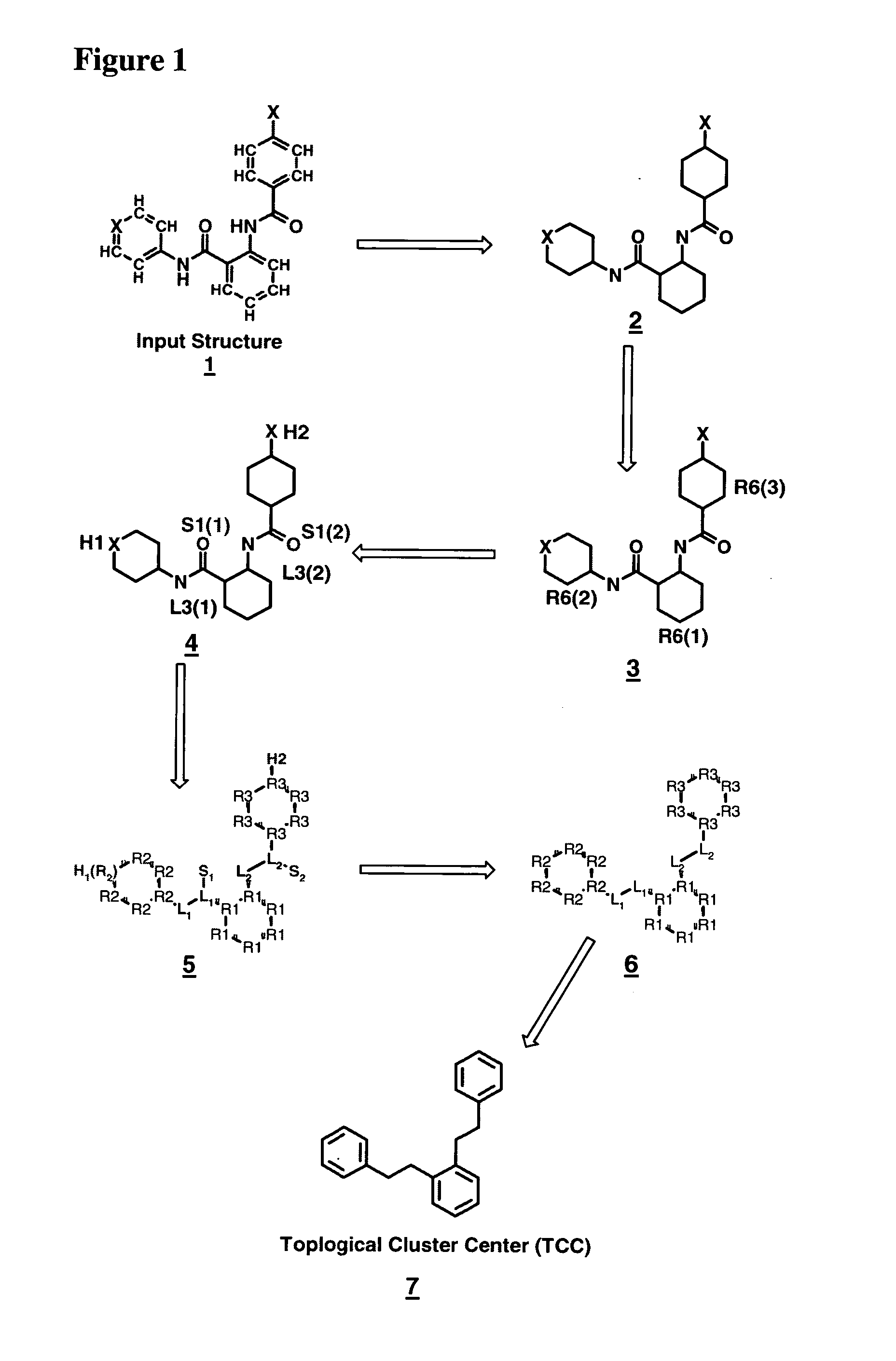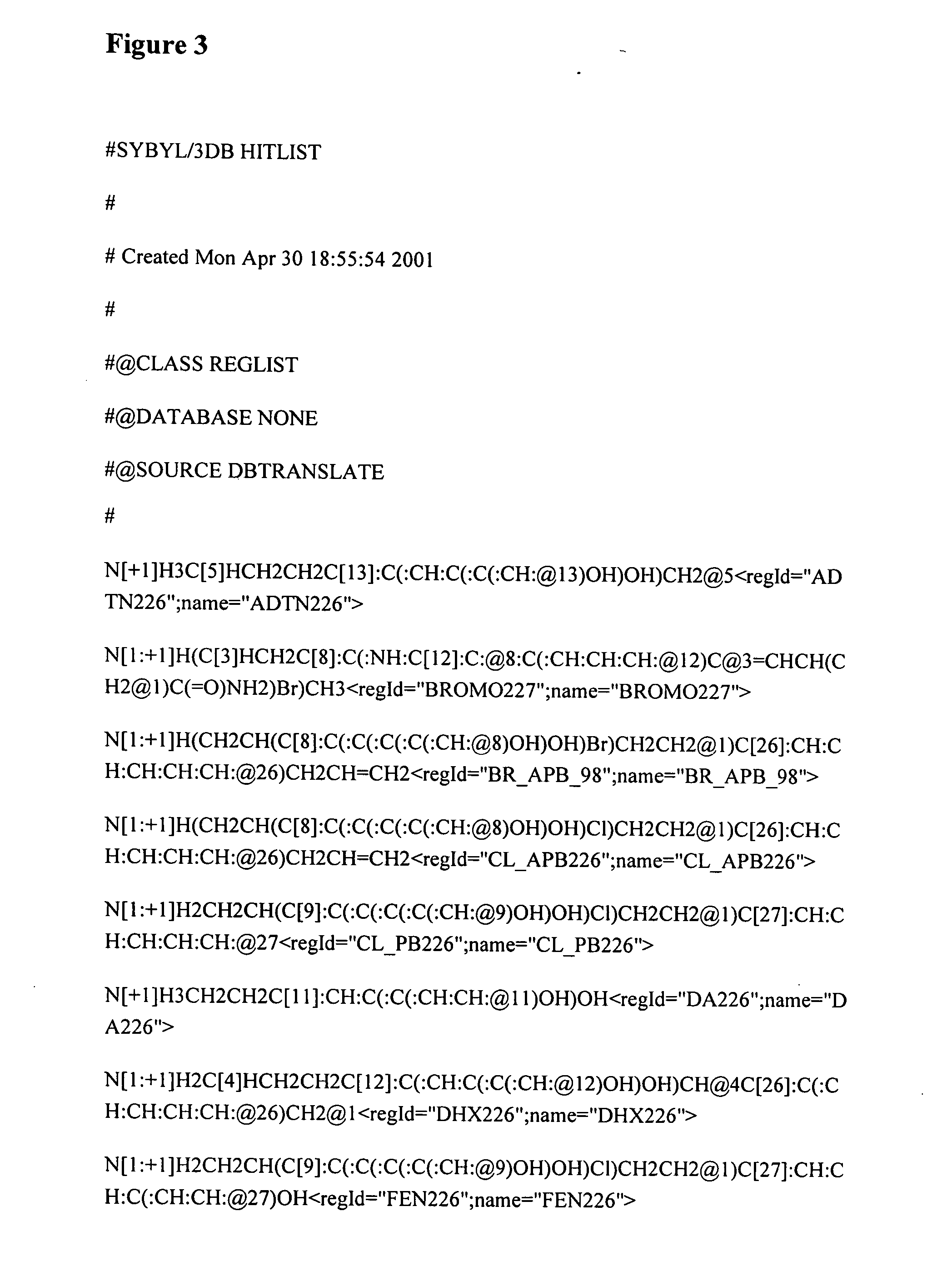Method for generating a hierarchical topological tree of 2D or 3D-structural formulas of chemical compounds for property optimisation of chemical compounds
a structure formula and hierarchical topological tree technology, applied in the field of new, can solve the problems of insufficient selfsimilarity in the dataset, inability to know the actual number of optimal clusters in advance, and the inability to classify compounds based on relative measures
- Summary
- Abstract
- Description
- Claims
- Application Information
AI Technical Summary
Benefits of technology
Problems solved by technology
Method used
Image
Examples
example 1
[0157]FIG. 1: illustrates selected steps for topology analysis in compounds and intermediate results generated from an example input structure 1 by applying the operating procedure steps (I.-VII.), prioritizing rules (1)-(5) and a)-d) in the recursive structural partitioning scheme for topological features, X represents an arbitrary heteroatom.
[0158] First the hydrogen-depleted graph (2) is generated, then the topological classes of the compound (shown color coded for their atom types) are processed sequentially, starting with the highest priority class e.g. rings (colored red, 3), proceeding through linkers (blue), heteroatoms (pale green) and substituents (or functional groups, orange, 4). For readability in black and white printings, the proper topological atom labels that define ring, linker and chain membership are also given for each substructure element. In course of this process the intra-class prioritization is determined for all classes sequentially. The final result of t...
example 2
[0159] Example for constructing the Topological Sequence Path (TSP) for compound 1 which has been processed as displayed in FIG. 1 (X=arbitrary heteroatom). Putative links to close topological neighbors that may be present in the input data but are not yet attached have been indicated by dashed double headed arrows that mark possible linkage at any intermediate level of detail in the TST. Double headed arrows indicate pointer information that allows for traversing up and down in Topological Structure Trees. Lowest level of detail (TST-root, red, 8) is the general six-membered ring which has top priority. From this extension of topological spheres around this central framework enlarges the structure by levels of detail following the rule-based prioritization scheme. Attached to the nodes of the TST are the Topological Sequence Code (TSC) Labels (in red) which may be used in place of the graphs (structures) to navigate through large scale data sets and through very complex Topological...
example 3
[0160] The input data for a Dopamine D1 and D2 agonist set taken from-literature (Wilcox R. E., Tseng T., Brusniak M. K., Ginsburg B., Pearlman R. S. Teeter M., Durand C., Starr S. and Neve K. A., CoMFA-based prediction of agonist affinities at recombinant D1 vs D2 dopamine receptors, J. Med. Chem., 1998, 41, 4385-4399) are shown in FIG. 3. Structures are coded in SLN (Sybyl Line Notation, Tripos Inc. St. Louis ), but Sybyl Mol2 files, MDL Mol files, Smiles format or SLN may be used in general for creating Topological Structure Trees using an in-house computer-program, which is based on the invention described herein.
PUM
| Property | Measurement | Unit |
|---|---|---|
| Structure | aaaaa | aaaaa |
| Size | aaaaa | aaaaa |
| Flexibility | aaaaa | aaaaa |
Abstract
Description
Claims
Application Information
 Login to View More
Login to View More - R&D
- Intellectual Property
- Life Sciences
- Materials
- Tech Scout
- Unparalleled Data Quality
- Higher Quality Content
- 60% Fewer Hallucinations
Browse by: Latest US Patents, China's latest patents, Technical Efficacy Thesaurus, Application Domain, Technology Topic, Popular Technical Reports.
© 2025 PatSnap. All rights reserved.Legal|Privacy policy|Modern Slavery Act Transparency Statement|Sitemap|About US| Contact US: help@patsnap.com



